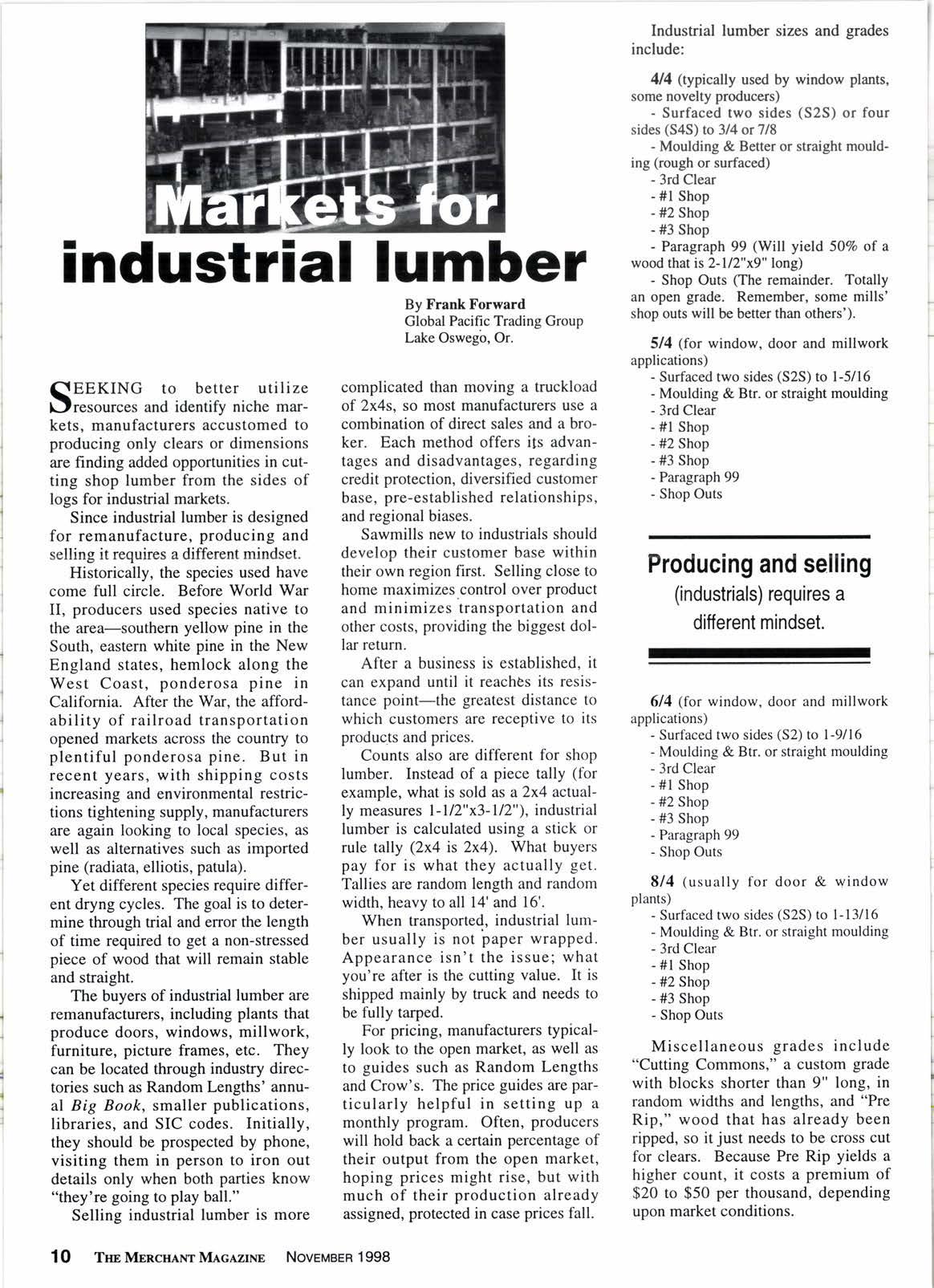
4 minute read
industrial lumber
By Frank Forward Global Pacific Trading Group Lake Oswegb, Or.
CIEEKING to better utilize Dr"rour.",
and identify niche markets, manufacturers accustomed to producing only clears or dimensions are frnding added opportunities in cutting shop lumber from the sides of logs for industrial markets.
Since industrial lumber is designed for remanufacture, producing and selling it requires a different mindset.
Historically, the species used have come full circle. Before World War II, producers used species native to the area-southern yellow pine in the South, eastern white pine in the New England states, hemlock along the West Coast, ponderosa pine in California. After the War, the affordability of railroad transportation opened markets across the country to plentiful ponderosa pine. But in recent years, with shipping costs increasing and environmental restrictions tightening supply, manufacturers are again looking to local species, as well as alternatives such as imported pine (radiata, elliotis, patula).
Yet different species require different dryng cycles. The goal is to determine through trial and error the length of time required to get a non-stressed piece of wood that will remain stable and straight.
The buyers of industrial lumber are remanufacturers, including plants that produce doors, windows, millwork, furniture, picture frames, etc. They can be located through industry directories such as Random Lengths' annual Big Book, smaller publications, libraries, and SIC codes. Initially, they should be prospected by phone, visiting them in person to iron out details only when both parties know "they're going to play ball."
Selling industrial lumber is more complicated than moving a truckload of 2x4s. so most manufacturers use a combination of direct sales and a broker. Each method offers its advantages and disadvantages, regarding credit protection, diversified customer base, pre-established relationships, and regional biases.
Sawmills new to industrials should develop their customer base within their own region first. Selling close to home maximizes.control over product and minimizes transportation and other costs, providing the biggest dollar return.
After a business is established, it can expand until it reachbs its resistance point-the greatest distance to which customers are receptive to its products and prices.
Counts also are different for shop lumber. Instead of a piece tally (for example, what is sold as a2x4 actually measures l-112"x3-112"), industrial lumber is calculated using a stick or rule tally (2x4 is 2x4). What buyers pay for is what they actually get. Tallies are random length and random width, heavy to all 14'and 16'.
When transported, industrial lumber usually is not paper wrapped. Appearance isn't the issue; what you're after is the cutting value. It is shipped mainly by truck and needs to be fully tarped.
For pricing, manufacturers typically look to the open market, as well as to guides such as Random Lengths and Crow's. The price guides are particularly helpful in setting up a monthly program. Often, producers will hold back a certain percentage of their output from the open market, hoping prices might rise, but with much of their production already assigned, protected in case prices fall.
Industrial lumber sizes and grades include:
414 (typically used by window plants, some novelty producers)
- Surfaced two sides (S2S) or four sides (S4S) to 314 or 718
- Moulding & Better or straight moulding (rough or surfaced)
- 3rd Clear
- #l Shop
- #2 Shop
- #3 Shop
- Paragraph 99 (Will yield SOVo of a wood that is 2-ll2"x9" long)
- Shop Outs (fte remainder. Totally an open grade. Remember, some mills' shop outs will be better than others').
514 (for window, door and millwork applications)
- Surfaced two sides (S2S) to l-5/16
- Moulding & Btr. or straight moulding
- 3rd Clear
- #l Shop
- #2 Shop
- #3 Shop
- Paragraph 99
- Shop Outs
Producing and selling (industrials) requires a different mindset.
614 (for window, door and millwork applications)
- Surfaced two sides (S2) to 1-9l16
- Moulding & Btr. or straight moulding
- 3rd Clear
- #l Shop
- #2 Shop
- #3 Shop
- Paragraph 99
- Shop Outs
8/4 (usually for door & window plants)
- Surfaced two sides (S2S) to 1-13/16
- Moulding & Btr. or straight moulding
- 3rd Clear -#l Shop
- #2 Shop
- #3 Shop
- Shop Outs
Miscellaneous grades include "Cutting Commons," a custom grade with blocks shorter than 9" long, in random widths and lengths, and "Pre Rip," wood that has already been ripped, so it just needs to be cross cut for clears. Because Pre Rip yields a higher count, it costs a premium of $20 to $50 per thousand, depending upon market conditions.
SELLING insulation is hardly ever a L)case of whatever is on the shelf will work. The world of insulation is expanding rapidly because of recent product innovations and the growth of alternative uses for insulation products beyond just thermal performance.
From insulation sheathings, roofing membranes and housewrap products to encapsulated fiberglass insulation batts, savvy dealers agree, you can use this product in your selling mix to build sales.
Recent studies have shown that insulation offers higher margins and faster turns than wall and floor coverings, bath fixtures and power tools. Properly merchandised and promoted, insulation can provide the average dealer with a GMROI rhat falls in rhe middle of the total range of returns for the majority of the main product groups in your store.
Whether your customers are professionals or d-i-yers, many will be seeking information on what to purchase and how best to install the product.
First and most crucial is to identify customer needs. Ask customers what project they are planning so you can quickly determine the product they need. Whether it is remodeling or new construction, both present options to add or upgrade insulation levels. Interior walls should also be insulated to reduce noise in the home.
Determining the most important areas to insulate, R-values, the amount of insulation, and selecting the proper insulation are common questions you need to be able to answer in the insulation aisle.










